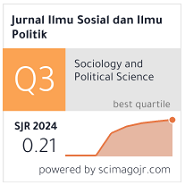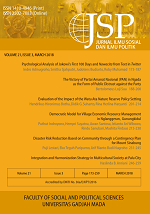The Data Journalism Practices in the Production of Investigative News Videos by Narasi TV
Nadia Intan Fajarlie(1*), Zainuddin Muda Z. Monggilo(2)
(1) Digital Department of Kompas TV, Indonesia
(2) Department of Communication Science, Faculty of Social and Political Sciences, Universitas Gadjah Mada, Indonesia
(*) Corresponding Author
Abstract
The digital and open data era has given rise to the development of methods in data journalism to create an in-depth or investigative news report. The widespread use of social media, dominated by the Y and Z generations, has also encouraged journalists to present the story in attractive formats. As one of the digital media in Indonesia, Narasi TV has data-based long-form stories called Buka Mata, presented in video forms and published through various social media. This research aims to answer the question, “How does Narasi TV produce the data journalism videos in Buka Mata?” to describe Narasi TV’s data journalism practices. This study uses a constructivist paradigm, a qualitative approach, and the case study method; and refers to the data journalism concept from The Data Journalism Handbook in 2012 to solve the research question. The findings show that Narasi TV has implemented data journalism practices such as gathering, verifying, analyzing, and visualizing data in producing Buka Mata. Furthermore, Narasi TV also uses an open-source intelligence (OSINT) method to create its investigative news videos.
Keywords
Full Text:
PDFReferences
Agarwal, S. (2017). Open source social media intelligence for enabling government applications. ACM SIGWEB Newsletter, Summer, 1–19. https://doi.org/10.1145/3110394.3110397
Ahn, J., & Jung, Y. (2016). The common sense of dependence on smartphone: A comparison between digital natives and digital immigrants. New Media & Society, 18(7), 1236–1256. https://doi. org/10.1177/1461444814554902
Asprilla, A., & Maharani, N. (2019). Jurnalisme Data Dalam Digitalisasi Jurnalisme Investigasi Tempo. Jurnal Kajian Jurnalisme, 2(2). https://doi.org/10.24198/JKJ.V2I2.21362
Australian Geospatial-Intelligence Organisation. (2021, October 12). Geospatial Intelligence (GEOINT). Australian Government Department of Defence. https://defence.gov.au/AGO/geoint.htm
Bounegru, L., Chambers, L., & Gray, J. (2012). The Data Journalism Handbook 1. In O’Reilly Media. https://datajournalism. com/read/handbook/one
Bradshaw, P. (2018). Zeroes and Ones: Investigating with Data. Digital Investigative Journalism, 19–29. https://doi.org/10.1007/978-3-319-97283-1_3
Fajarlie, N. I. (2022, September 26). Akun Media Sosial 24 Pegawai dan Eks Pegawai Narasi TV Diserang Peretas. Kompas TV. https://www.kompas.tv/article/332129/ akun-media-sosial-24-pegawai-dan-eks- pegawai-narasi-tv-diserang-peretas
Hahn, O., & Stalph, F. (2018). Digital Investigative Journalism. Digital Investigative Journalism, 1–6. https://doi. org/10.1007/978-3-319-97283-1_1
Hanifah, A. N., & Monggilo, Z. M. Z. (2022). Fact-Checking and Check-Worthiness Determination on Tempo.co during Covid-19 Pandemic. Jurnal ASPIKOM,7(1), 32–43. https://doi.org/10.24329/ASPIKOM.V7I1.1063
Higgins, E. (2018). Visual Analysis: Verification via Geolocation and Photographs. Digital Investigative Journalism: Data, Visual Analytics and Innovative Methodologies inInternational Reporting, 137–142. https://doi.org/10.1007/978-3-319-97283-1_13
Kalogeropoulos, A. (2019). How Younger Generations Consume News Differently. In Reuters Institute Digital News Report. https://www.digitalnewsreport.org/ survey/2019/how-younger-generations- consume-news-differently/
Kencana, W. H., & Djamal, M. F. (2021). Startup Television: New Form In Digital Journalism. IKRA-ITH HUMANIORA : Jurnal Sosial Dan Humaniora, 5(2), 1–12. https://journals.upi-yai.ac.id/index.php/ ikraith-humaniora/article/view/961
Lehren, A. W. (2018). The Rise of Investigative Data Journalism. Digital Investigative Journalism: Data, Visual Analytics and Innovative Methodologies in International Reporting, 9–17. https://doi. org/10.1007/978-3-319-97283-1_2
Lewis, N. P. (2021). Defining and Teaching Data Journalism: A Typology. Journalism and Mass Communication Educator, 76(1), 78–90. https://doi. org/10.1177/1077695820924309
Lewis, S. C., & Usher, N. (2013). Open source and journalism: toward new frameworks for imagining news innovation. Sage Journals, 35(5), 602–619. https://doi.org/10.1177/0163443713485494
Manan, A., & Ningtyas, I. (2020). Laporan Tahunan AJI 2020 Di Bawah Pandemi dan Represi (A. Manan, Ed.). AJI Indonesia. www.aji.or.id
McGregor, S. C. (2019). Social media as public opinion: How journalists use socialmedia to represent public opinion. Journalism, 20(8), 1070–1086. https://doi. org/10.1177/1464884919845458
McLaughlan, P. (n.d.). LibGuides: How to do a Video Essay: What is a Video Essay? Retrieved March 7, 2023, from https://ecu.au.libguides.com/c.php?g=670376&p=6249752
Monggilo, Z. M. Z. (2019a). Konteks Indonesia modul 5: Praktik pemeriksaan fakta. In Kuskridho Ambardi, Novi Kurnia, Rahayu, & Zainuddin Muda Z Monggilo (Eds.), Jurnalisme, “Berita palsu”, & disinformasi konteks indonesia (pp. 24–31). Departemen Ilmu Komunikasi UGM.
Monggilo, Z. M. Z. (2019b). Konten media sosial untuk konten jurnalistik: Verifikasi adalah kunci. In Kusridho Ambardi, Novi Kurnia, Rahayu, & Zainuddin Muda Z Monggilo (Eds.), Jurnalisme, “Berita palsu”, & disinformasi konteks indonesia (pp. 32–37). Departemen Ilmu Komunikasi UGM.
Monggilo, Z. M. Z. (2020). Jurnalis Indonesia di masa pandemi covid-19: Kisah profesi dan catatan harapan. In D. H. Santoso, Nurudin, & F. Junaedi (Eds.), Media, komunikasi dan informasi di masa pandemi covid-19.
Mutsvairo, B. (2019). Challenges Facing Development of Data Journalism in Non- Western Societies. Digital Journalism, 7(9), 1289–1294. https://doi.org/10.1080/21670811.2019.1691927
Onuoha, M., Pinder, J., & Schaffer, J. (2015). Guide to Crowdsourcing. https://www. cjr.org/tow_center_reports/guide_to_crowdsourcing.php#crowdsourcing-in- newsrooms
Parahita, G. D., & Monggilo, Z. M. Z. (2021). Indonesian government responses to covid-19 disinformation: Some lessons learned. https://eastasia.innovationforchange. net/wp-content/uploads/2022/04/211008- Indonesia.pdf
Purba, P. G. T. (2020, January 6). Klaim ZEE Indonesia di Natuna Jangan Sekadar di Peta Saja. D W Indonesia. https:// www.dw.c om/id/pengam at-klaim-zee-indonesia-di-natuna-utara-jangan- sekadar-di-peta-saja/a-51901802
Radü, J. (2018). Visual Storytelling: Show, Not Tell? Show AND Tell. In Digital Investigative Journalism (pp. 113–122). Springer International Publishing. https://doi.org/10.1007/978-3-319-97283-1_11
Richelson, J. T. (2018). The U. S. Intelligence Community. (Seventh Edition). Routledge. https://books.google.co.id/books?id=30d aDwAAQBAJ&printsec=frontcover&hl=i d&source=gbs_ge_summary_r&cad=0#v=onepage&q&f=false
Roza, A. M. (2020, January 22). Tantangan Jurnalisme Data di Era Hoaks dan Disinformasi. Katadata. Co. Id. https://katadata.co.id/redaksi/indepth/5e9a498ff2916/tantangan-jurnalisme-data-di-era-hoaks-dan- disinformasi
Siregar, A. (2003). Etika Jurnalisme Televisi di Tengah Disorientasi Negara dan Pasar. Jurnal Ilmu Sosial Dan Ilmu Politik, 7(2), 227–242. https://doi.org/10.22146/JSP.11073
Steele, J. (2018). Mediating Islam Jurnalisme Kosmopolitan di Negara-Negara Muslim. Bentang Pustaka.
Steensen, S., & Westlund, O. (2020). What is Digital Journalism Studies? (1st Edition). Routledge. https://doi.org/10.4324/9780429259555
Thienthaworn, E. (2018). Data journalism: Principle development and knowledge adaptation in Thailand [NIDA Library Repository]. http://repository.nida.ac.th/ handle/662723737/4366
Utomo, W. P. (2020, December). Eps 36-Menggunakan OSINT untuk Liputan Jurnalistik Ft Aqwam Fiazmi Hanifan. Spotify. https://open.spotify.com/ep isode/6bVvELdKDypjsvdfbY3lRK?s i=ixHcL shmRuCrxub9XXQOZw& u tm_source=copy-link&nd=1
Widiantara, K. A. (2021). Tren Dan Fenomena Jurnalisme Data Pada Media Online Di Indonesia. DANAPATI: Jurnal Komunikasi, 1(2), 118–125.
Wood, M. G. (2017, October 23). Social Media Intelligence. Privacy International. https:// privacyinternational.org/explainer/55/ social-media-intelligence
Yin, R. K. (2017). Case study research and applications: Design and methods (Sixth Edition). SAGE.
Article Metrics
Refbacks
- There are currently no refbacks.
Copyright (c) 2023 Jurnal Ilmu Sosial dan Ilmu Politik

This work is licensed under a Creative Commons Attribution-ShareAlike 4.0 International License.






















